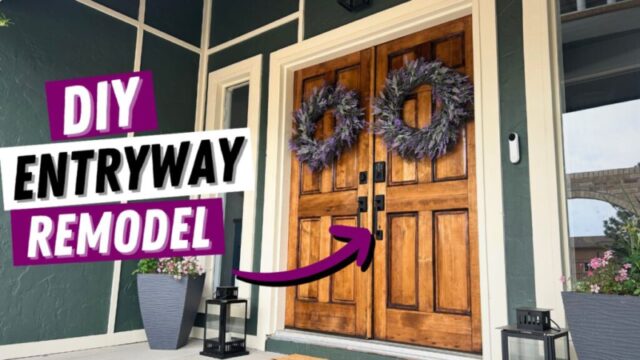DIY Entryway Overhaul
You only get one chance to make a first impression! It’s true in all aspects of life including your front door. Unfortunately when it came to our house, the front entryway was looking pretty drab and gross. Not to worry, I tackled a full DIY Entryway Overhaul complete with front Door Restoration and new hardware with the help from my friends from Minwax and Schlage! If you’re interested in watching the whole entry transformation, check out the full video here.
This project contains paid product integrations from Minwax and Schlage Locks. All opinions herein are my own. This post also contains affiliate links for your convenience. Visit my disclosure page for more information on affiliate and compensation this site accepts.
The Issue:
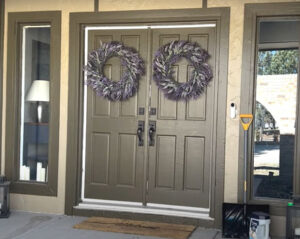 The various shades of brown paint on the doors and surrounding area really don’t stand out against the beige brick that features on the majority of the house. Also, the solid wood doors have been painted over umpteen times and have lost their character.
The various shades of brown paint on the doors and surrounding area really don’t stand out against the beige brick that features on the majority of the house. Also, the solid wood doors have been painted over umpteen times and have lost their character.
The Goal:
The goal of the project is to bring some visual interest to the front entryway with sharp contrast against the beige brick, and a combination of tones and textures.
Step 1: Paint (the Walls)
I think when it comes to painting, there’s not much to say. Pretty self explanatory, right? Well there are a few helpful tips that I can share about painting to make your life easier.
-
- Make sure you choose the right nap for your roller! Nap refers to the length of the fibers on the roller. A higher Nap means longer fibers so it is better suited to get into the nooks and crannies of a rougher surface. A lower nap number means it’s better suited for a smoother surface. For this project I’m using a 3/4″ nap for the rough walls and a 1/4″ nap for the smooth trim pieces.
- Taping – I’m not a huge fan of using a lot of tape for a couple reasons. #1 is that it creates a lot of waste to deal with, and #2 is it tends to give people a false sense of security and lets you be sloppy. However, a lot of tapes bleed under the edge and you end up having to fix it later anyway, adding a lot of time to the project. I use Frog Tape mostly and make sure to wet the edge of the tape when I put it up which activates their edge lock adhesive and gives much cleaner tape lines.
Step 2: Strip Paint On the Doors
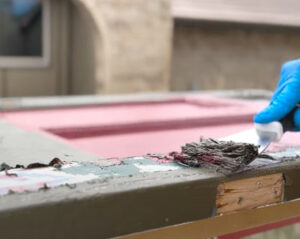 There’s no secret in saying that restoring old doors is a lot of work and not the most fun one can have on a weekend! However, replacing wooden doors can also be extremely expensive so if you can spare the time and don’t mind a little hard work, you can get beautiful results. The first step is to use paint stripper. Add a generous coat(s) and let it sit for about 15 minutes and then come back through with a good, solid metal scraper and take your time peeling the layers off. You may have to do it several times depending on the amount of paint on the doors. Wear your gloves, eye protection, and a good respirator because this stuff can be noxious!
There’s no secret in saying that restoring old doors is a lot of work and not the most fun one can have on a weekend! However, replacing wooden doors can also be extremely expensive so if you can spare the time and don’t mind a little hard work, you can get beautiful results. The first step is to use paint stripper. Add a generous coat(s) and let it sit for about 15 minutes and then come back through with a good, solid metal scraper and take your time peeling the layers off. You may have to do it several times depending on the amount of paint on the doors. Wear your gloves, eye protection, and a good respirator because this stuff can be noxious!
Step 3: Sand the Doors
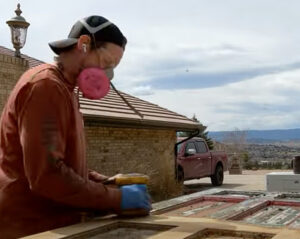 After stripping, it’s not uncommon to feel like you’ve really made a mistake. It will likely look horrible! But don’t worry, get out a sander with some 80 grit paper and get to work. You’ll quickly start to see the raw wood and start to feel better about your decision. Work your way up through the grits until at least 220 grit. (I usually go 80 grit, 120 grit, and 220 grit)
After stripping, it’s not uncommon to feel like you’ve really made a mistake. It will likely look horrible! But don’t worry, get out a sander with some 80 grit paper and get to work. You’ll quickly start to see the raw wood and start to feel better about your decision. Work your way up through the grits until at least 220 grit. (I usually go 80 grit, 120 grit, and 220 grit)
Pay close attention to the details. The more detail your door has, the harder it’s going to be. It can be pretty tricky to get into those spaces but I recommend getting a small wire brush, sanding sponges, and utilizing paint stripper as much as possible to make your life easier. It takes time, there’s no way around that!
Step 4: (Pre) Stain the Doors
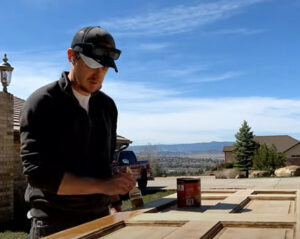
Choosing the right stain products for your doors is important. I like to use Oil-Based products on any outdoor project because it provides a more durable, harder finish over the longterm than its water-based counterpart. DON’T MIX AND MATCH oil and water-based. I also always like to use a quality Minwax Oil-based pre-stain conditioner. The pre-stain conditioner evens out the wood to create a more uniform stain look and remove any unsightly blotching that can sometimes occur. It’s especially important on old doors that have previously had other finishes previously applied. I applied it with a cheap chip brush and let it set up for about 30 minutes before staining.
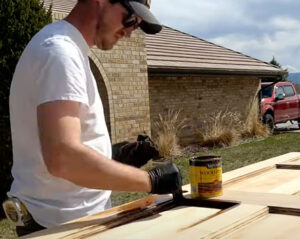
For this project I chose the Minwax Oil-based Early American stain for the doors. I thought it gave a nice, warm contrast to the green and tan trim we chose for our color scheme. For staining, I also used a chip brush and followed it up with a rag to wipe off any excess after it sat on the wood for a few minutes. For more staining tips, check out this previous project article.
Step 5: Seal the Doors
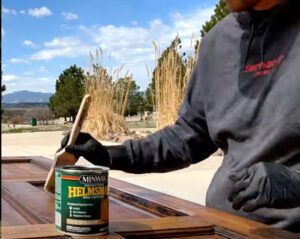 A quality top coat can be a make or break step for restoring doors. In professional setups, they have a dedicated spray booth to get the best quality application possible. But you’re not a pro so just do your best. You can still get a great finish. I chose to use the Minwax Oil-based Helmsman Spar Urethane on these doors. It’s a great, durable finish that will provide years of UV and weather protection. I applied it with a brand new, high quality bristle brush in the direction of the wood grain and allowed it to set up according to the dry time on the can. Then I sanded the doors lightly with 400 grit paper and applied another coat. Then I repeated that process again for a solid 3 coat application.
A quality top coat can be a make or break step for restoring doors. In professional setups, they have a dedicated spray booth to get the best quality application possible. But you’re not a pro so just do your best. You can still get a great finish. I chose to use the Minwax Oil-based Helmsman Spar Urethane on these doors. It’s a great, durable finish that will provide years of UV and weather protection. I applied it with a brand new, high quality bristle brush in the direction of the wood grain and allowed it to set up according to the dry time on the can. Then I sanded the doors lightly with 400 grit paper and applied another coat. Then I repeated that process again for a solid 3 coat application.
Step 6: Update the Hardware
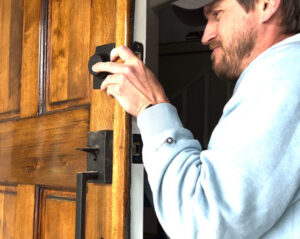 Lastly, to get a modern/rustic vibe, it’s time to update the hardware on the doors. I used the Century Matte Black Hardware and Century Touch Deadbolt from my friends at Schlage Locks.These doors required a little updating in order to install the new hardware which included installing a new patch in the old strike plate area and chiseling it out so it has a nice finished look. If you want to learn more about how to fix your old doors to install new hardware and update strike plates, make sure you check out this video where I walk you through the whole process!
Lastly, to get a modern/rustic vibe, it’s time to update the hardware on the doors. I used the Century Matte Black Hardware and Century Touch Deadbolt from my friends at Schlage Locks.These doors required a little updating in order to install the new hardware which included installing a new patch in the old strike plate area and chiseling it out so it has a nice finished look. If you want to learn more about how to fix your old doors to install new hardware and update strike plates, make sure you check out this video where I walk you through the whole process!
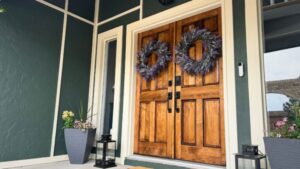
So that’s it for this project! I hope you enjoyed it and I hope it inspires you to tackle a door project you may have been too nervous to take on!
If you’re interested in learning more about staining and/or restoring old furniture and household items, check out these other articles.


